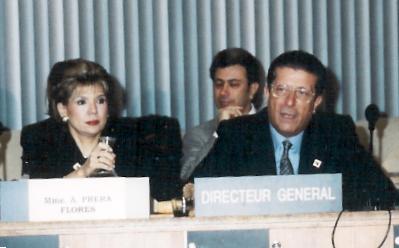Introduction and UNESCO's Mandate
Page 1
Yamousoukro and Seville Statement
Page 2
Origins and Executive Board Adoption
Pages 3 - 4
Launching the Programme: El Salvador and Roundtable
Pages 5 - 6 - 7
1993 General Conference
Page 8
National Projects
Pages 9 - 10
Programme Unit
Page 11
Toward a Global Scope
Pages 12 - 13
Transdisciplinary Project and Human Right to Peace
Pages 14 - 15 - 16
1997: A New Approach
Page 17
UN General Assembly Resolutions
Page 18
Resolution for International Year
Page 19
Declaration and Programme of Action
Pages 20 - 21
Resolution for International Decade
Pages 22 - 23
Training Programmes
Page 24
Global Movement
Pages 25 - 26
Publicity Campaign
Pages 27 - 28
Decentralized Network
Pages 29 - 30
Manifesto 2000
Page 31
Use of Internet
Pages 32 - 33
Future of the Culture of Peace
Pages 34 - 35 - 36 - 37 - 38
In three main ways Director-General Mayor implemented the decision of the 1995 General Conference that the culture of peace should be the priority for UNESCO. First, he undertook intensive personal diplomacy with Heads of State and leaders of intergovernmental organizations and the civil society, engaging his newly appointed personal advisors in this effort . Second, he established the Transdisciplinary Project "Towards a Culture of Peace" by which he mobilized the UNESCO sectors in a series of coordinated activities contributing to this theme. And third, he proposed an additional human right, the "human right to peace".
The intensive personal diplomacy of the Director-General for the culture of peace is beyond the documentation available to me. Traces are presumably contained in the official notes taken during his numerous meetings (perhaps thousands) with visitors and on missions throughout the world during the years 1996-1999. In addition, there were many off-the-record discussions and diplomacy undertaken by his personal advisors. Another kind of documentation consists of the many declarations by international organizations that were inspired by this diplomacy (see list contained in Appendix 2 of General Assembly Document A/53/370 which is included here as Annex VI). Another source of information is the body of letters written in support of the International Year for the Culture of Peace to governmental and non-governmental leaders throughout the world as called for in the strategy documents of Anaisabel Prera-Flores such as that of 18 July 1998 (see the list of letters in the publicity campaign below.
Despite the lack of documentation for much of this campaign, there should be no doubt about the remarkable dynamism and charisma of Mr Mayor's advocacy and its mobilizing effect for the culture of peace.
The Transdisciplinary Project "Towards a Culture of Peace" was built on previous initiatives to involve the different sectoral programmes of UNESCO, as described in the document for the General Conference 28 C/123 (20 September 1995), which mentioned the International Conference on Education, the Associated Schools Project, the Tolerance programme, violence in the media, UNESCO clubs, projects in field offices and meetings with religions for a culture of peace. We proposed, during 1996, a Blue Note of the Director-General for management of the project but this was not forthcoming until 16 June 1997. Meantime, meetings with the sectors were held on 9, 16 and 17 December 1996. As always, however, the lines of authority at UNESCO remained hierarchical and did not lend themselves easily to coordination on a horizontal level.

The Director-General assigned responsibility for the management of the Transdisciplinary Project to his advisor for Latin America, Anaisabel Prera Flores. Ms Prera Flores had been the delegate of Guatemala on the Executive Board when the culture of peace was first received by the Board in 1992. Her responsibility was eventually formalized in the Director-General's Blue Note of 16 June 1997, but had begun informally well before then. Following the first meeting of the Internal Co-ordinating Group for the Transdisciplinary Project on 12 September 1997, she and her team prepared a series of documents and meetings, including those of 9 and 12 February 1998, 4 June 1998, 17 July 1998 and 16 February 1999 that attempted to mobilize the full strength of UNESCO behind the Culture of Peace Project.
 |
 |
 |